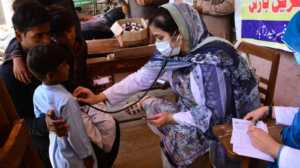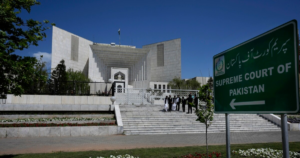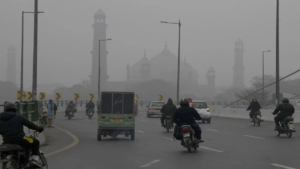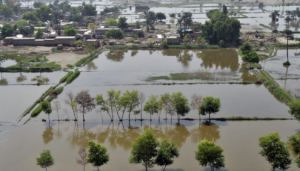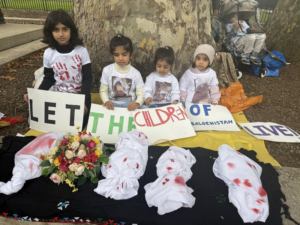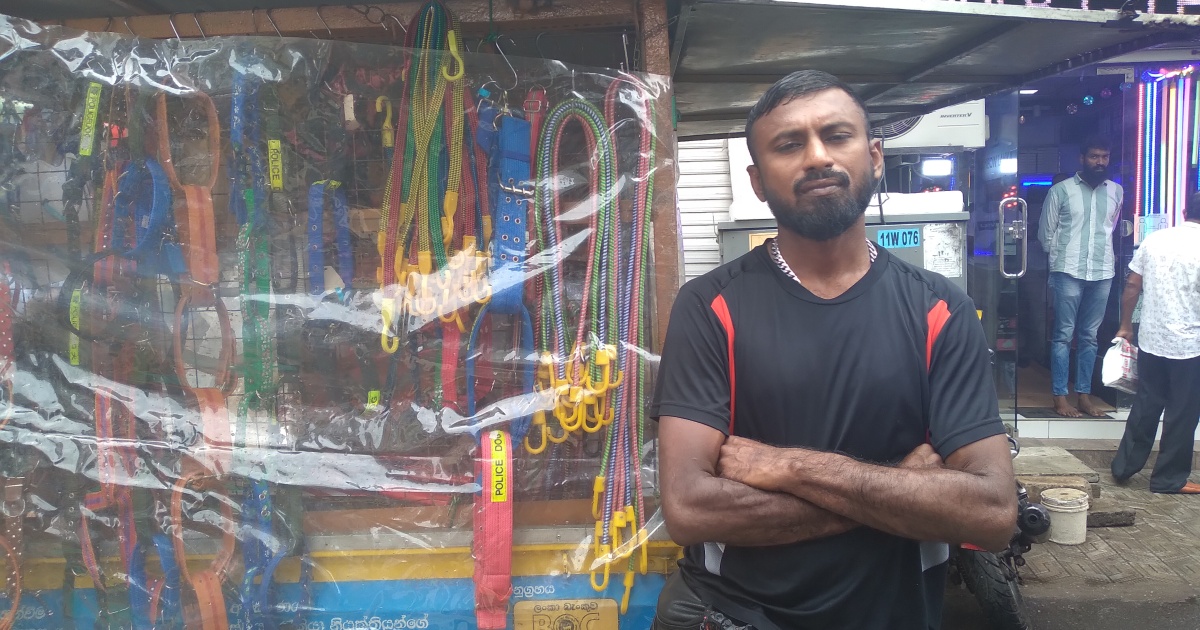
Amid soaring costs and 80% food inflation, a trader in Colombo is forced to eat less, ration medicine and buy fuel on the black market to get by.
This story is part of a series of portraits exploring how the cost-of-living crisis is affecting people around the world.
Colombo, Sri Lanka – Mohamed Rajabdeen’s four-wheel yellow mini-truck, known locally as a tempo, is parked at a street corner in Colombo’s Pettah market, one of the city’s busiest and most bustling shopping districts. The back of his vehicle opens on all three sides, doubling up as a vending stall, from which he sells a mix of first- and second-hand goods.
He points to a large grey toolbox sitting amid spanners, wires and car jacks. “You see this?” he asks. “Earlier, it was LKR5,000 or LKR6,000 ($14 or $17). Now? It’s LKR10,000 ($28). I got this months ago and it’s still unsold.” Previously he could sell up to three per week.
Sri Lanka has been reeling under a severe economic crisis since March. Petrol and diesel supplies are limited, and kilometre-long fuel queues have become common in the capital. Inflation has hit consumer goods and food items alike. Experts blame a variety of factors: ballooning debt, a drop in tourism and foreign remittances, and political mismanagement.
“Our country’s situation is very bad,” says Rajabdeen. “No measures are being taken to control inflation.” Like millions of others in the island nation, the 35-year-old’s life and business have taken a hit. “How to manage?” he asks with a disconsolate shrug, dressed in jeans and a black t-shirt with a pouch containing cash slung across his waist. There are no easy answers.
Since he was a child, Rajabdeen has worked on and off with his father, who he calls the “boss”. The older man, aged 62, sits nearby in a shirt-and-sarong looking over the table in front that is also heaped with goods, including plugs, locks, screwdrivers and pliers.
The market is relatively busy, though nothing compared with what it was before the crisis. Still, the rains have mostly held off, and people are bustling around, shopping for electronics, fruits, clothes and other bric-a-brac. The duo come here almost daily to hawk their wares. But sales have been on the lower side for the past several months.
“Customers don’t have money, they are buying less,” says Rajabdeen, who finished school but never went to university. As the oldest son of the family, he had to enter the workforce quickly to help support the others.
Food: ‘We have to think twice’
Food inflation hit 80 percent in June, and at least six million Sri Lankans are food insecure, according to the World Food Programme. From salt to rice, Rajabdeen says all staples have become prohibitively priced. Daily life has become a series of careful recalibrations, from dietary to lifestyle changes.
“Since vegetable prices have gone up, we are cooking them less,” he says. He no longer eats chicken daily. “Meat is expensive. If we take a day off from work, then we can’t afford to eat chicken that day.” The days of barbecuing at home are also behind him. “Now we have to think twice.”
Rajabdeen no longer starts and ends the day with a glass of fresh milk as frequently as he used to. Because the price of 750ml of fresh milk has risen from 220 to 490 Sri Lankan rupees ($0.61 to $1.36), he says he now drinks just 10 percent of the amount he previously did. Although most other people get by on milk powder, Rajabudeen wants none of that ersatz stuff. He grew up with ready access to the best milk, thanks to a relative who had a dairy farm, and will not give it up entirely.
As a coffee drinker, he grimaces when asked about tea, Sri Lanka’s number one export and the second-most consumed drink in the world. “When you mix tea into milk, it isn’t as good.”
It is not just what Rajabdeen eats that has changed, it is also how. Cooking gas supplies are hard to source; serpentine queues of people sitting with their gas cylinders have become a common sight. In his home, all the cooking gets done in an electric rice cooker – typically, as the name suggests, used to make rice. Now it is more of an all-purpose magic pot used to cook different things. “Everyone is doing that,” he chuckles, “a lot of time we make biryani. It’s a one-shot meal.”
Does he feel hungry sometimes? “Somehow we manage, we try to control our hunger. How to eat? Where is the money? Business has gone slow, no?” he replies. Items like biscuits and chocolates feel like luxury treats now and have been taken off the shopping list.
Although he is not a huge sweet eater, his children have a sweet tooth, one that he has had little opportunity to indulge lately. He points to the shop at a corner near the entrance to the market. “You see Bombay Sweets?” he asks. Inside, behind their glass panels, squares and diamonds of white, cream and green-coloured sweets sit neatly in metal trays. “Ask them, they know me,” he continues. “I used to be their favourite customer. Every day I used to buy something from there.” He bought ladoos, and pretty much anything, he laughs. Now these indulgences feel out of reach.
Black-market fuel, high electricity costs
The struggle for fuel is also daily and ongoing. Rajabdeen is up against the same challenges as his compatriots. “There is no proper infrastructure for distributing fuel,” he says. Fuel costs between 450 to 550 Sri Lankan rupees ($1.25 to $1.53) and is nearly impossible to buy unless you spend days in line. But today, he is somewhat pleased because he has managed to refuel at last.
He has bought several litres of diesel from the thriving black market, a market that has boomed since the demand and supply skew has come to dominate the country. One month ago, he paid 1,000 Sri Lankan rupees for a litre ($2.78), but it has now spiked to 3,000 Sri Lanka rupees ($8.34). “We spoke to so many people, and with great difficulty we got it,” he says.
His father was sceptical at first when they bought the fuel, unsure if it was good quality. They own two vans, including the tempo used for business and a three-wheeler. He last used the three-wheeler three months ago. From time to time he buys small amounts of fuel for this vehicle, but not to actually ride it. “We use it just to keep starting the engine, to keep it active. We keep it in the same spot,” he says.
His father often sleeps over at the market because they cannot afford to drive their tempo back home every day; meanwhile, Rajabdeen cycles 10km (6 miles) back and forth each way.
Rajabdeen has served stints in the railways and in the textiles sector, but he prefers to work with his father for now. He also has entrepreneurial ideas of his own, though few resources at the moment to realise them. “This is not my life,” he says. “I have big ideas and big plans.”
It starts to rain and Rajabdeen rushes to pull down a plastic sheet to protect his goods. He then whips out his electricity bill, tracing his finger through the ballooning numbers. It tallies up to 835 Sri Lankan rupees ($2.32) for the last month, higher than the usual 500 Sri Lankan rupees ($1.39). Arrears are piling up too.
Even though there are frequent power cuts, lasting up to four hours per day, managing electricity usage is a challenge of its own. “We use the fan less and switch off the fridge at night,” he says.
‘Let us hope’
The crisis has also pushed Rajabdeen’s wife – until now a homemaker – into the workforce. “How to do it otherwise? How to manage?” he asks. She now goes to work in other people’s homes.
His son and two daughters have not been to school in weeks. The government ordered schools in several areas to be shut down during the crisis because of power cuts and fuel shortages to transport children. “The children are so sad that school is closed,” he says.
The country is also facing a severe shortage of medicines. Rajabdeen takes tablets to control his diabetes, but this has become irregular recently. “How to buy?” he asks. A combination of a lack of fuel, a low supply of medicines at government hospitals, and a paucity of time have all led to him neglecting his health.
But his woes did not begin this year with the economic crisis. COVID-19 was a terrible time too, with the lockdown and thinning business. And the roots of his cynicism go even further back. In April 2019, armed men bombed a series of churches and hotels in and around Colombo. The Easter attacks, as they came to be known, killed 269 people. A wave of Islamophobia followed, stoked by some hardline Buddhist majority voices. “We faced a lot of problems. [The majority] campaigned and said don’t buy our [Muslim community’s] food, don’t buy our groceries, don’t come to our hotels,” Rajabdeen recalls. The country’s population is about 9.7 percent Muslim and 70 percent majority Buddhist.
What remains of the country’s future? “Dead,” Rajabdeen says. “But let us hope for the best.”
He used to be a film buff once, he shares, often going to the cinema to watch movies, but he has other responsibilities now.
Thinking of the movies brings a smile to his face as he recalls a serendipitous event from not long ago. In April, around the time the protests began at Colombo’s Galle Face Green, Rajabdeen was in queue with his yellow three-wheeler, a vehicle he bought in 1987. A film crew member from an upcoming sports biopic spotted it and approached him. Could they use it for their shoot, they asked.
Subsequently, Rajabdeen also ended up getting a small cameo in the movie, playing a soldier. He beams as he shows off his military green cap, a prop from the set that he managed to take home. It was a rare and thrilling opportunity, perhaps one that would not have come but for the peculiar circumstances of queueing for fuel. “God gave me this chance,” he smiles.
This reporting was supported by the International Women’s Media Foundation.



